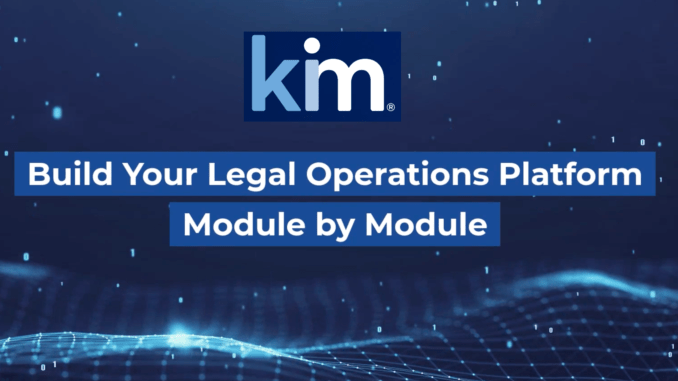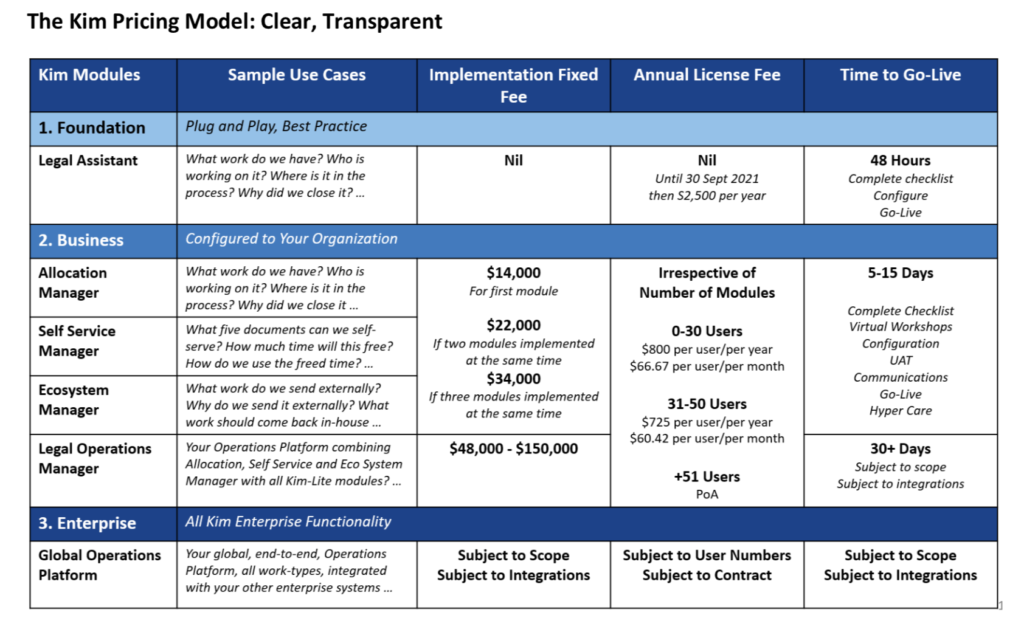
Kim Technologies, the legal operations data platform, has launched a tiered range of modules that will allow small- to medium-size businesses to make use of the software. Also, in what is still a relatively rare move in the legal tech world, the company has made public part of its pricing.
The idea is that by offering a modular approach, ranging from a free Legal Assistant, to a group of new Business level offerings, to eventually the full Enterprise package, a broader range of clients can build what they want, while knowing – at least partially – how much it will all cost.
To give a sense of scale, the Business package is offered to companies that may have up to 50 users. Normally, the company works with very large enterprises, including EY Law.
Karl Chapman, Director at Kim, told Artificial Lawyer that some of the applications already exist, but are effectively being repackaged for a wider market. For example, the Legal Assistant, which helps with work intake, already is available and will be offered for free.
While the range of products on offer will be useful (see more below), for Artificial Lawyer one of the key aspects here is an effort to be more transparent on pricing.
Legal tech has inherited many of the bad habits of the legal profession when it comes to pricing, with customers having little idea what things will cost them. That slows down sales and generally creates an environment where value is harder to ascertain.

The three tiers include the legal assistant mentioned above, then there is the Business tier, which provides applications such as:
- Allocation Manager: to receive, allocate and track work
- Self Service Manager: free the legal team by self-serving internal clients.
- Ecosystem Manager: manage the allocation and tracking of work to law firms/other providers.
- Legal Operations Manager module. This module is a ‘Lite’ version of the Kim Global Enterprise Platform and includes all functionality from intake management through self-service, re-direction or allocation and more.
The top tier is the main offering of Kim’s Global Legal Operations Platform, which also already exists.
Is this a big deal? As mentioned, transparency on at least some of the pricing is a welcome change, especially in these times. As to the tiered levels, this shows how legal tech companies that may have started off focused on the big ticket large corporations, are now looking to sell to smaller inhouse legal teams – which of course there are many more of.
The FTSE 250 and Fortune 500 companies tend to get all the attention, but medium to smaller companies that may still be interested in purchasing useful tech – if it can be implemented easily and won’t cost an arm and a leg – outnumber this group of mega-corporations by several million on a global basis.
Of course, the irony is that the lawyers in this very much larger market segment find it hard to focus on matters beyond legal work, such as buying in new technology, and also have limited resources to spend on software.
It’s the same dilemma with law firms. Smaller practices outnumber the global firms that buy most of legal tech’s applications by a gargantuan margin, but, selling to these smaller law firms is a challenge.
However, where there is a potential market there will be tech companies, such as Kim, with strategies to gain traction there.